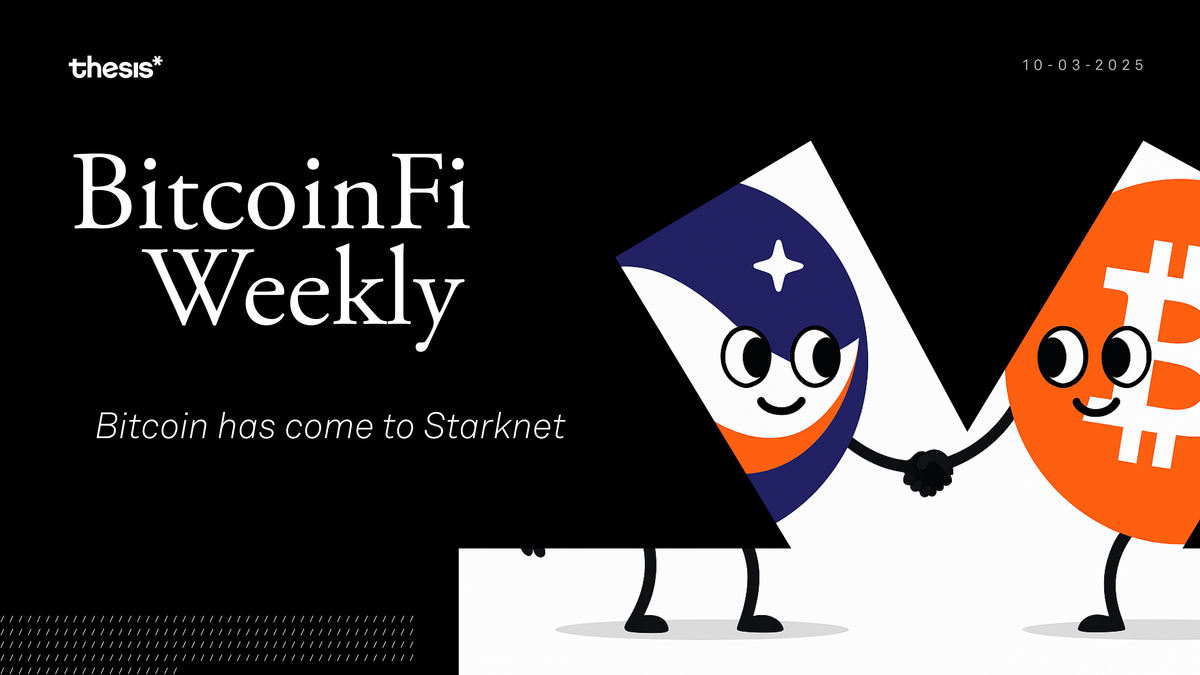Bitcoin has come to Starknet
Bitcoin hits Starknet with 100M STRK incentives, YieldBasis solves impermanent loss for BTC LPs, and Asymmetry unveils Sunbeam for BTC yields through stablecoin infrastructure. Plus: institutions buying BTC forces retail to get creative with BitcoinFi strategies.

Welcome to BitcoinFi Weekly. We cover where people use their BTC and what is changing in the Bitcoin world.
Bitcoin used to be simple: you bought it, held it, and waited. But somewhere between the halvings and the headlines, something shifted. The suits showed up. Nation-states started stacking sats. MicroStrategy turned into a Bitcoin black hole, and El Salvador's volcano bonds don't seem so crazy anymore. While institutions vacuum up supply with their infinite fiat, retail's left watching the scoreboard. The HODLer's dilemma just got real: how do you accumulate when the big players are pricing you out? It's time to make your sats work as hard as the institutions work to acquire them.
Here’s this week’s rundown:
🌟 Featured Piece: Bitcoin has come to Starknet
⚖️ YieldBasis attempts to solve impermanent loss for BTC
☀️ Asymmetry launches Sunbeam
🏛️ Lombard is live with $BARD
Feature Piece: Bitcoin has come to Starknet
Starknet, an Ethereum Layer-2 network developed by StarkWare, entered 2025 with a mindset of making Starknet the “execution layer” for Bitcoin. Unlike most L2s built for quick EVM compatibility, Starknet took the harder route—developing its own VM (Cairo) and scaling with STARK proofs. That foundation now lets it tackle problems beyond Ethereum, including extending programmability to Bitcoin.
2024 was when StarkWare truly ventured into Bitcoin by publishing their research on a mechanism called CIRCLE-STARK – a modified STARK proof system especially suited to Bitcoin’s environment. By using smaller cryptographic field sizes, they showed it’s possible to verify STARK proofs within Bitcoin script (despite Bitcoin’s limits). Starknet devs showed they could verify Bitcoin’s entire block header chain in 25 ms on a Raspberry Pi using CIRCLE-STARK proofs. The long-term goal is a trustless two-way bridge, with Starknet running computation and anchored to Bitcoin for security.
After over a year of R&D, Starknet launched “BTCFi Season” at Token2049 Singapore, introducing the first-ever way to stake Bitcoin on a Layer-2. Holders delegate wrapped BTC (like WBTC, tBTC, or LBTC) to Starknet validators and earn STRK rewards (note that yield is not paid in BTC). Staking design preserves Starknet’s governance balance: BTC-based consensus power is capped at 25%, with the remaining 75% tied to STRK stakes.
To fund yields, Starknet announced a 100M STRK incentive program. This funding is directed into lending markets, liquidity pools, and staking yields, aiming to make Starknet the cheapest place to borrow against BTC and the most attractive venue to deploy Bitcoin in DeFi. It’s worth noting that the yields in this ecosystem are not solely reliant on STRK token incentives. Many are organic yields (derivatives premiums, trading fees, interest from borrowers) turbocharged by modest incentives. Staking options can be viewed here.
The launch also featured a slate of new partnerships and applications. On the institutional side, RE7 Capital introduced its mRE7BTC and mRE7USD yield vaults, bringing professional-grade, market-neutral strategies (like basis trading and arbitrage) into Starknet’s DeFi. Meanwhile, Vesu went live with Vesu Vaults, providing permissionless money markets with curated yield products for BTC wrappers.Several new applications also joined Starknet’s ecosystem with BTCFi’s launch:
- Spline, a stableswap protocol for wrapped BTC assets.
- Noon, a yield-generating stablecoin.
- Uncap, a Starknet-native Bitcoin money market.
- Troves, offering one-click leveraged BTC yield farming strategies.
- 0D Finance, a structured yield product suite.
On the integrations front, WBTC, LBTC, SolvBTC, and tBTC are live on Starknet.
How does Starknet differ from prior staking models?
Let’s take Babylon, for example. Babylon is the more “Bitcoin-native” model: BTC never leaves the Bitcoin chain, so custody risk is minimal, but yields are low (sub-1%) and tied to securing PoS chains like Cosmos zones. Starknet, by contrast, brings wrapped BTC onto its rollup, which introduces bridge trust but enables BTC to actively secure Starknet itself and participate in DeFi. That means higher baseline yields (~2–3% in STRK from staking) plus additional returns from lending, vaults, and structured strategies. Starknet aims to bridge Bitcoin and Ethereum’s liquidity pools, while Babylon focuses on smaller PoS chains.
Of course, success is not guaranteed. Starknet will need to prove that its complex system (Cairo VM, novel bridges, decentralized sequencers, etc.) can operate smoothly and securely at scale. Early hiccups – such as a 9-hour network outage during a September 2025 upgrade– highlight that the job ain’t done, far from it infact.
Additionally, convincing Bitcoin-maxis to entrust their BTC to a smart contract on a new network may take time, even if the contracts are audited and the yields enticing. Competition will also persist: protocols like Rootstock (RSK) and Stacks have long tried (with limited traction) to bring Bitcoin into smart contracts.
Nonetheless, Starknet’s BitcoinFi initiative has momentum.
BitcoinFi Updates
Yield Basis attempts to solve impermanent loss for BTC
YieldBasis is a new attempt to solve one of DeFi’s oldest problems: impermanent loss. AMMs force liquidity providers to hold assets in a 50/50 split, which means that as prices move, LPs underperform simple holding. YieldBasis changes that by restructuring liquidity around leveraged positions.
Instead of depositing both BTC and stablecoins, users deposit only BTC. The system automatically borrows crvUSD against that collateral and creates a 2× leveraged BTC/crvUSD LP position. A specialized AMM anchored to an oracle plus arbitrageurs keeps the debt ratio at roughly 50%, so the position always tracks BTC’s price one-to-one while still collecting trading fees. For users, it looks simple: deposit BTC, receive ybBTC, and watch it grow in line with BTC plus yield. Under the hood, fees are split between unstaked holders, stakers earning YB emissions, and veYB governance lockers via a dynamic fee model designed to keep incentives balanced.
The launch paired this mechanism with an ambitious raise. Curve DAO approved a $60M crvUSD credit line to back the pools, giving the system borrowing power from day one. YieldBasis became the first project to use Legion’s merit-based allocation model combined with Kraken’s regulated launchpad. The result was one of the most oversubscribed raises in recent memory: $150M+ committed in 24 hours against a $2M target, with tokens priced at a $200M FDV and 100% unlocked at TGE. The structure ties YB directly into Curve governance (7.5% streamed to veCRV voters) while setting aside ~30% for liquidity incentives and ~40% for team and investors under vesting.
The combination of a structural fix for AMMs and a new fundraising template is why this matters. YieldBasis could draw in wrapped BTC, restaked BTC, and even portions of idle BTC into DeFi pools that previously weren’t worth the risk. At the same time, its raise demonstrates a credible path for token launches that are fairer to retail and aligned with compliance. The next test will be in live performance: whether trading fees consistently cover rebalancing and borrow costs, whether Curve’s infrastructure remains stable under load, and whether YB’s incentive design keeps participants engaged without subsidies.
Asymmetry launches Sunbeam
Sunbeam is Asymmetry Finance’s new Bitcoin-focused product, unveiled during their September 30 AMA. It is built on top of USDAf, the protocol’s stablecoin, and is designed to increase USDAf’s circulating supply and collateral base. Every dollar that enters Sunbeam interacts with USDAf contracts, meaning activity in Sunbeam directly contributes to protocol revenue. The project has completed internal review, is currently in security review, and will proceed to external audit before launch.
Sunbeam targets Bitcoin holders—both institutions and individuals—who are seeking onchain yield but have historically had limited options. By tying Bitcoin deposits to USDAf’s mechanics, Sunbeam channels liquidity back into the broader Asymmetry ecosystem. The team described it as “positive sum” for USDAf and ASM, and positioned it as part of a broader segmentation strategy alongside their stablecoin products and leveraged tools like Multiply. While exact deployment timelines and mechanics are still being finalized, Sunbeam represents Asymmetry’s effort to unlock Bitcoin liquidity in a way that complements its existing CDP and stablecoin infrastructure.
Lombard is live with $BARD
Lombard launched its native token $BARD on September 18. BARD governs protocol decisions, secures cross-chain LBTC transfers through staking, and directs resources to ecosystem development via the Liquid Bitcoin Foundation. At launch, 22.5% of supply entered circulation, with the rest vesting over four years, reflecting a long-term distribution design aimed at aligning contributors, investors, and users.
On September 30, Lombard reported its first week of staking rewards. Over 2,000 unique participants staked BARD, collectively earning 36,833 tokens distributed during the initial epoch. Learn more here.
Closing Thoughts
The old guard said Bitcoin was perfect as-is—no changes or yield required, just pure, pristine scarcity sitting in cold storage. However, capital has a way of finding its highest use, and Bitcoin is proving it's more than a museum piece. From Starknet's STARK proofs to YieldBasis's impermanent loss solution, from Lombard's BARD governance to a dozen new yield vaults, Bitcoin enables earn. The tools for the circular Bitcoin economy are here
If there's a topic you’d like us to cover or have questions, reach out at [email protected].





